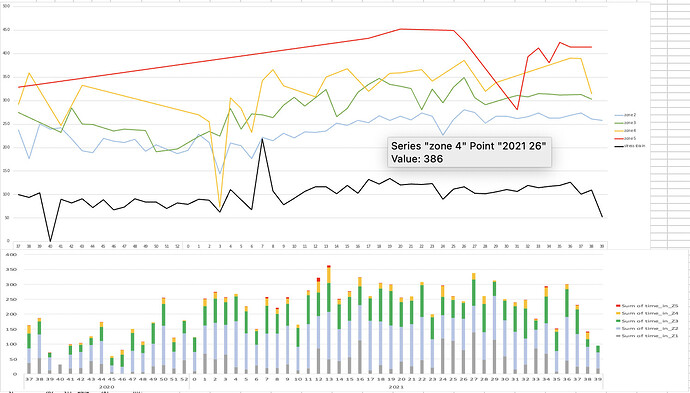I researched a variation of Polarised Training this year. It worked great for me. Now I want to share my learnings and see if more people can benefit from it.
What’s in it for you
Consistent week-by-week performance improvement with reduced injury risk, increased motivation and reduced recovery requirements.
What I ask of you
Try the concept for at least 6 weeks and post your results here.
What did I research?
I researched the performance effects of COmpressed Polarised Intensity Distribution (COPID).
In COPID training, each training session is an interval session consisting of 80% zone 2 and 20% zone 3 or 4. There is no rest. There is no zone 5. Intervals are medium length (between 30 and 120 seconds).
Why did I research COPID
After reading lots of research and analysing my own swimming and speed skating results, it occurred to me that there might not be a good reason for high-intensity training. Now that is shocking thought!
Just imagine for a second what that would mean for your injury risk, the stress on your body, your mood after training and your recovery time.
To improve your (race) performance, you need to increase your strength and your endurance. Endurance is effectively improved by zone 2 efforts. Strength is improved by 'frequently applying 50% of or more of your 1-repeat-max.
Additionally, we know that ‘the longer you put the pressure on’, the more stress you cause and the higher the injury risk becomes.
I therefor reasoned that zone 2 combined with short, moderate accelerations might be the secret formula for a save way to gold.
What did I accomplish
Well, see below how my power output increased this year with only 250 to 350 minutes of work per week:
I’d like to remark that:
- the measurements or done ‘outside in uncontrolled circumstances’. Therefor the trend is much more important than the individual values. But the results are clear. Strong and steady improvement in every HR zone, with hardly any time spent in zones 4 and 5.
- After week 27 of 2021 I started a new experiment…I increased the length of my intervals, which resulted in more stress, more DOMS, less volume, less progress.
- top graph: x is weeknumber in the years 2020 and 2021, y= watts
- bottom graph: x is weeknumber in the years 2020 and 2021, y= minutes of training
Why is that result of interest
The power increase might not be superior compared to classic PID, but since there is no ‘Time in Zone 5’, I never felt exhausted, never ripped a muscle or tendon apart, never lost balance because of tired muscles.
The second point of interest is that the power increase seems quite significant for the amount of training.
And thirdly, the power output in zone 5 (racing) improved in line with the improvements in the other HR zones.
How can you do it
- use any tool to create interval sessions that meet the follow criteria:
– zone 2 is your basis
– intervals are between 30 and 120 seconds, with heart rate zone 3 as the target
– set your interval target to zone 4 instead of 3 if you are free of DOMS
– spread the intervals evenly throughout the first 80% of your session.
– finish the last 20% of the session in zone 2
– add some warm-up and cooldown - set the initial duration of a session to something you know you can do. You can extend from there.
Tips:
- determine your current power output/speed for a steady heart rate in zone 3 and 4. During your intervals, you accelerate to, and hold the ‘known’ power output/speed, so you will not overshoot your heart rate target.
- Use your heart rate monitor to stay ‘within the target zone’. (for the 30 second intervals you might need to monitor power/speed if your HR is slow to respond)
- accelerate moderately for the intervals, not fast (to reduce the injury risk)
What I hope to learn from your results
- Does this work equally well if you train much less, or if you train much more?
- Can you PB using this method?
- Do you experience the same benefits (no injuries, no demotivation resulting for exhaustion, better motivation because of more variation in your session and ‘weekly improvements’.
- Do you also experience improvements in your technique because of the intra-session speed variations?
- Did you see a change in VO2max?
Looking forward to your results, as well as all your thoughts and challenges on this method.
